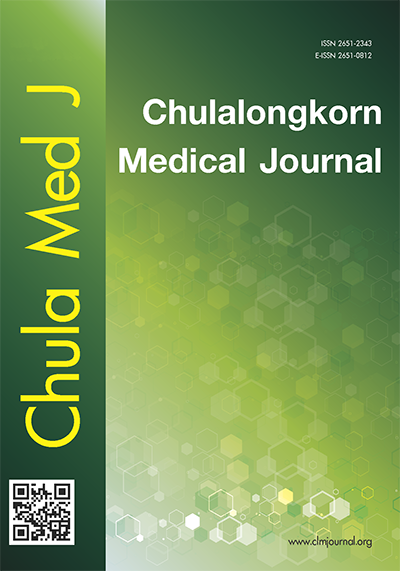Neonatal morbidity and mortality of very low birth weight infants at King Chulalongkorn Memorial Hospital
Keywords:
Very low birth weight infant, Neonatal mortality, Neonatal morbidityAbstract
Background : The number of very low birth weight (VLBW) infants in tertiary care hospitals in Thailand is rising continuously. Nevertheless, available data about their morbidity and mortality have not yet been established.
Objective : To determine the neonatal morbidity and mortality of VLBW infants admitted at a tertiary care hospital in Bangkok.
Methods : Medical records of all newborns with birth weight of <1500 grams (VLBW) at King Chulalongkorn Memorial Hospital during 2003 -2005 were analyzed. Care provided to the infants was based on the same practical guideline. Early nasal continuous positive airway pressure (CPAP) was the common practice and exogenous surfactant was only used as a rescue therapy for Idiopathic Respiratory Distress Syndrome (IRDS). Five items of morbidity, i.e., bronchopulmonary dysplasia (BPD), retinopathy of prematurity (ROP), necrotizing enterocolitis (NEC), osteopenia and intra-ventricular hemorrhage (IVH) were included. All deaths occurred during hospitalization were included irrespective of postnatal age.
Result : There were 284 VLBW infants including 15 out - borns. The ratio of infants with birth weight <1000 grams to 1001-1499 grams was 97:187. Their gestational age ranged between 22-41 weeks. The total incidence of BPD, ROP, NEC, osteopenia, IVH and death were 39 (13.7%), 27 (9.5%), 50 (17.6%), 14 (4.9%), 32 (11.3%) and 35 (12.3%) respectively. เท comparison with the group of larger infants, infants with birth weight <1000 grams had_higher incidence of BPD (21.6% vs 9.6%), (OR 2.59; 95%CI, 1.31-5.15), ROP (16.5% vs 5.9%), (OR 3.16; 95%CI, 1.40-7.11) and IVH (26.8% vs 3.2%), (OR 11.05; 95%CI, 4.36 - 27.97), p-value <0.005 for all. The incidence of NEC and osteopenia were not statistical different. Their mortality rate was also higher (28.9% vs. 3.7%), (OR10.43; 95%CI, 4.36 - 24.99), p-value < 0.005. Major causes of death were extreme immaturity, severe birth asphyxia, severe IRDS and nosocomial infection. Among the survival infants, none of them had blindness, hydrocephalus, bone deformity or requires oxygen supplement.
Conclusion : This study demonstrates a satisfactory outcome of the VLBW infants at a tertiary care hospital. Survival rate is 87.7%. Their survival with relatively mild degree of morbidity is encouraging.
Downloads
Downloads
Published
How to Cite
Issue
Section
License
Copyright (c) 2023 Chulalongkorn Medical Journal

This work is licensed under a Creative Commons Attribution-NonCommercial-NoDerivatives 4.0 International License.










